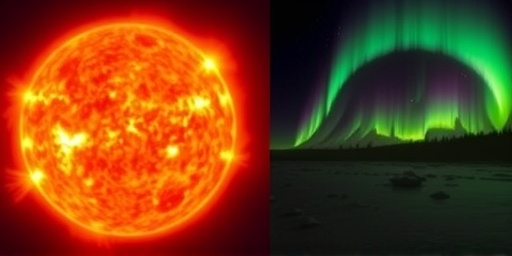In a stunning display of space weather volatility, a powerful X-class Solar flare erupted from the Sun just before dawn today, unleashing a cascade of charged particles that temporarily disrupted satellite communications and GPS signals across the continental United States. NASA scientists confirmed the event, classifying it as one of the strongest solar eruptions in recent years, with potential effects lingering for hours or even days. While no major infrastructure failures have been reported yet, the flare has already caused blackouts in radio communications for airlines and maritime vessels, prompting emergency alerts from federal agencies.
- X2.5 Solar flare Erupts: NASA’s Real-Time Detection and Solar Dynamics
- Widespread Communications Blackouts Grip US Skies: From GPS Glitches to Airline Delays
- Rare Aurora Displays Light Up Southern Skies: Florida Residents Prepare for Celestial Show
- Space Weather Experts Issue Alerts: Preparing for Prolonged Solar Impacts
The flare, originating from an active region on the Sun’s surface known as AR 3664, peaked at X2.5 intensity around 4:15 a.m. ET, according to real-time data from NASA‘s Solar Dynamics Observatory (SDO). This Solar flare event is part of a broader surge in solar activity as the Sun approaches the peak of its 11-year cycle, expected to intensify through 2025. Eyewitnesses in the Midwest reported flickering GPS navigation in vehicles and intermittent loss of AM radio signals, underscoring the real-world communications disruption caused by this cosmic phenomenon.
X2.5 Solar flare Erupts: NASA’s Real-Time Detection and Solar Dynamics
The solar flare was first detected by NASA‘s suite of space-based observatories, including the SDO and the joint NASA-NOAA Solar Ultraviolet Imager (SUVI). These instruments captured the flare’s explosive release of energy—equivalent to millions of hydrogen bombs detonating simultaneously—in extreme ultraviolet light. AR 3664, a sunspot cluster larger than Earth itself, has been a hotspot for solar activity this week, producing multiple M-class flares leading up to today’s X-class monster.
According to Dr. Elena Patel, a space weather physicist at NASA‘s Goddard Space Flight Center, “This solar flare represents a significant escalation in solar output. The X2.5 rating means it’s over twice as powerful as an X1 flare, with the potential to ionize Earth’s upper atmosphere and scatter radio waves.” Patel’s team has been monitoring the region closely since Sunday, when initial magnetic instability was noted. Historical data shows that X-class flares like this one occur roughly once every few months during solar maximum, but their impacts can vary based on the direction of the ejected plasma.
The flare was accompanied by a coronal mass ejection (CME), a billion-ton cloud of solar material hurtling toward Earth at speeds up to 1.5 million miles per hour. NASA models predict the CME will arrive late today or early tomorrow, potentially amplifying the communications disruption. In 1989, a similar event blacked out Quebec’s power grid for nine hours; while today’s flare isn’t projected to cause blackouts on that scale, utilities are on high alert.
Historical Context: How This Flare Compares to Past Solar Storms
Looking back, the 1859 Carrington Event—caused by an even larger solar flare—disrupted telegraph systems worldwide and produced auroras visible in the Caribbean. More recently, the 2003 Halloween Storms, a series of X-class flares, knocked out satellites and caused blackouts in Sweden. Today’s event, while not as extreme, echoes these precedents. Space weather experts at the National Oceanic and Atmospheric Administration (NOAA) have issued a G2 geomagnetic storm watch, the second-highest level, indicating moderate risks to power grids and high-frequency radio.
Statistics from NASA reveal that solar flares have increased by 30% in frequency since the start of 2024, correlating with the Sun’s magnetic field reversal. Over 50 X-class events have been recorded since 1976, with 15% leading to significant Earth impacts. This flare’s timing, during peak daylight hours for much of the U.S., minimized some visual effects but maximized interference with daytime-dependent systems like aviation comms.
Widespread Communications Blackouts Grip US Skies: From GPS Glitches to Airline Delays
The communications disruption began almost immediately after the flare’s peak, as X-rays and ultraviolet radiation from the solar flare bombarded Earth’s ionosphere—the layer of the atmosphere that reflects radio signals. This ionization created a sudden blackout in high-frequency (HF) radio bands, essential for long-distance aviation and maritime navigation. The Federal Aviation Administration (FAA) reported temporary rerouting of 12 transcontinental flights due to lost radar contacts over the Great Plains.
GPS users felt the pinch too. Satellite navigation systems rely on precise timing signals, which the flare’s radiation temporarily jammed. Drivers in states like Illinois and Missouri shared videos on social media of navigation apps freezing or providing erroneous directions, with error margins ballooning to over 100 meters in some cases. “We saw a 20-minute blackout in our fleet’s GPS tracking,” said Tom Reilly, operations manager for a Chicago-based logistics firm. “It was chaos on the interstates.”
Beyond consumer impacts, the communications disruption affected critical infrastructure. Power companies in the Northeast monitored transformers for geomagnetically induced currents, while amateur radio operators experienced total silence on 20-meter bands. NOAA’s Space Weather Prediction Center logged over 500 reports of interference within the first hour, a spike 10 times higher than average. Satellite operators, including those for Starlink and Iridium, activated backup protocols to mitigate signal loss, but experts warn that the incoming CME could extend disruptions into the weekend.
- Key Affected Systems: HF radio (aviation, military), GPS (vehicles, surveying), Satellite TV and internet relays.
- Duration: Initial blackouts lasted 10-30 minutes; secondary effects possible for 24-48 hours.
- Geographic Scope: Primarily continental U.S., with minor reports from Canada and Mexico.
In a statement, FCC Chair Jessica Rosenworcel emphasized, “Space weather events like this solar flare remind us of our vulnerability to solar influences. We’re coordinating with NASA to ensure resilient communications networks.” This incident highlights ongoing investments in space weather forecasting, with the U.S. government allocating $150 million annually to NOAA and NASA programs.
Rare Aurora Displays Light Up Southern Skies: Florida Residents Prepare for Celestial Show
As the silver lining to this solar flare‘s fury, skygazers are buzzing about potential aurora sightings as far south as Florida and Alabama tonight. The influx of solar particles is expected to energize Earth’s magnetosphere, creating vibrant displays of the Northern Lights—technically aurora borealis—visible well below the usual 60th parallel. NASA aurora forecasts predict Kp index levels of 6-7, indicating strong geomagnetic activity that could paint the skies in greens, purples, and reds.
Residents in northern states like Minnesota and Maine can expect a near-guaranteed show, but the real excitement lies in the South. “This could be a once-in-a-decade opportunity for Southerners to witness the aurora without traveling north,” enthused Dr. Sarah Jenkins, an astrophysicist at the University of Florida. Jenkins recounted the 2023 solar storm that brought faint auroras to Georgia; today’s event promises brighter spectacles. Apps like Aurora Forecast and My Aurora have already seen downloads surge by 40% as enthusiasts plan viewing parties.
Optimal viewing conditions include clear, dark skies away from city lights, with the show peaking between 10 p.m. and 2 a.m. ET. However, the communications disruption might ironically hinder live-streaming efforts, as some internet services could falter. Social media is abuzz with tips: use long-exposure photography on smartphones, face north, and bundle up against the chill.
- Best Viewing Spots: Everglades National Park (FL), Great Smoky Mountains (TN/NC), Lake Michigan shores (MI).
- Expected Colors: Dominant green from oxygen excitation; rare red from high-altitude nitrogen.
- Safety Note: Avoid staring at the Sun directly, even during flares—use certified solar filters.
This aurora event ties into broader space weather education efforts by NASA, which launched the Aurora Chaser app last year to demystify these phenomena for the public.
Space Weather Experts Issue Alerts: Preparing for Prolonged Solar Impacts
As NASA and NOAA ramp up monitoring, space weather experts are urging preparedness for extended effects from this solar flare. The incoming CME could trigger radio blackouts through Sunday and elevate risks to satellites, with over 1,000 active in low-Earth orbit potentially facing orbital drag or electronic glitches. SpaceX’s Crew Dragon missions and the International Space Station crew have been briefed on radiation exposure protocols.
Dr. Patel from NASA added, “While the communications disruption is concerning, it’s a natural reminder of the Sun’s power. We recommend backup power for critical devices and monitoring official alerts.” International partners, including the European Space Agency, report similar preparations, as the flare’s effects ripple globally.
Looking ahead, this event underscores the need for advanced space weather resilience. NASA‘s upcoming Parker Solar Probe missions aim to delve deeper into flare mechanics, potentially improving predictions by 50% within five years. For now, Americans are advised to check NOAA’s space weather scales and secure non-solar-dependent comms alternatives. As solar maximum builds, experts forecast more such events, blending awe-inspiring aurora with practical challenges in our tech-reliant world.
The fusion of natural spectacle and modern vulnerability will likely spur policy discussions, with Congress eyeing expanded funding for space weather defenses. Tonight’s auroras may captivate, but tomorrow’s recovery efforts will test our infrastructure’s mettle.









